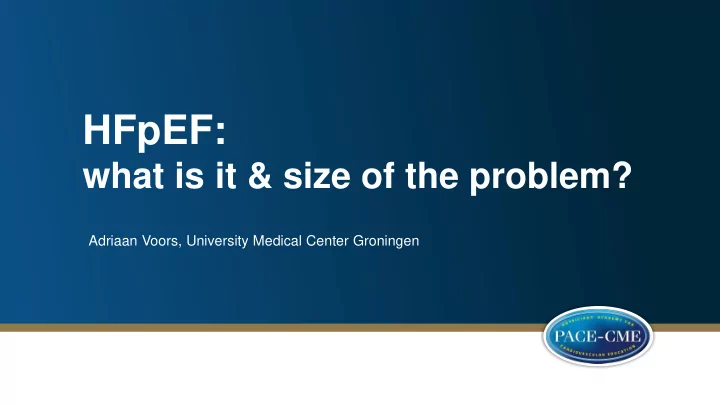

HFpEF: what is it & size of the problem? Adriaan Voors, University Medical Center Groningen
History of HFpEF • 1992 a review paper entitled ” diastolic heart failure” was published by Pravin Shah and Ramdas Pai. • A few quotes: - “ Diastolic heart failure is a distinct clinical entity increasingly seen in older patients and requires special awareness to make the diagnosis” - “It appears that prognosis is significantly better for those with normal systolic function.” - “Diastolic heart failure is difficult to treat.”
Is HFpEF “real” HF? 1995 European Society Guidelines for diagnosis of HF: “Conclusive evidence that most elderly patients with a diagnostic label of heart failure but with normal systolic function at rest do indeed have heart failure is lacking.”
HFrEF = diastolic dysfunction Distribution of Ejection Fraction and Diastolic Dysfunction Among Patients with Heart Failure *Mild diastolic function represents impaired relaxation mitral inflow patterns with normal filling pressures; moderate diastolic dysfunction represents impaired relaxation mitral inflow patterns with elevated filling pressures or a pseudo normal mitral inflow pattern with elevation of filling pressures; and severe diastolic dysfunction represents restrictive mitral inflow patterns ** Patients with isolated diastolic dysfunction Bursi et al. JAMA 2006
HFpEF = systolic dysfunction Average Longitudinal and Circumferential Systolic Strain HFpEF Controls LVEF LVEF HHD HFpEF overall LVEF (n=50) 45-50% 50-55% (n=44) (n=219) >55% Longitudinal 0% Circumferential -5% -10% HFpEF – Heart Failure with Preserved Ejection Fraction -15% HHD – Hypertensive Heart Disease LVEF – Left Ventricular Ejection Fraction -20% -25% * P <0.0001 compared to controls and between HHD and HFpEF overall for longitudinal strain and circumferential -30% strain # P – 0.0002 compared to controls † LVEF -adjusted p < 0.001 compared to controls Average longitudinal and circumferential systolic strain among normal controls, HHD, HFpEF patients, and in 3 categories HFpEF based on LVEF
“Other phrases have been used to describe diastolic HF, such as HF with preserved ejection fraction (HFPEF), HF with normal ejection fraction (HFNEF), or HF with preserved systolic function (HFPSF). We have elected to use the abbreviation HFPEF in this document.”
Prevalence of HFpEF 13 Community Based Studies 1997- 2006 100% Median = 52% HFpEF Prevalence Mean = 55% 80% 60% 40% 20% 0% Hogg et al, JACC, 2004, Owan et al, Prog Cardiovas Dis, 2005 Owan et al, NEJM, 2006; Bursi F et al, JAMA, 2006
Trends in HFpEF prevalence 60% Proportion of Hospitalized ~ Heart Failure Patients EF > 50% 50% 40% ~ EF < 40% 30% 20% ~ EF > 40-50% 10% 0% 2005 2006 2007 2008 2009 2010 2011 2012 2013 2014 2015 2016 2017 2018 2019 2020 year Oktay, Rich, Shah Curr Heart Fail Rep 2013
Patient with HFpEF are different from HFrEF Age: HFpEF > HFrEF Females: HFpEF > HFrEF Hypertension: HFpEF > HFrEF HFpEF ≥ HFrEF Obesity: HFpEF ≥ HFrEF Diabetes: CAD: HFpEF < HFrEF Lam et al Eur J Heart Fail 2011
Prevalence of non-cardiac comorbidities in Heart Failure groups 60% 50% 40% 30% 20% 10% 0% Thyroid COPD Anaemia Obesity PAD Stroke CKD Diabetes dysfunction Streng et al. Int J Cardiol 2018
Pathophysiology of HFpEF Diabetes,Obesity, Hypertension Inflammation, EndMT, Oxidative Stress, Fibroblast Activation NO-cGMP-PKG Endothelial Dysfunction Titin changes Fibrosis Diastolic Dysfunction Tschope and Lam Herz 2012
HFpEF: More than comorbidities Cardiovascular and HFpEF Trials: 76 80 Overall Mortality 70 Per 1000 patient years 54 60 53 47.2 50 40 28.7 25.6 30 17.3 16.4 15.7 20 11.4 10 0 HFpEF Trials Cardiovascular Trials Campbell J Am Coll Cardiol 2012
HFpEF: More than comorbidities Cardiovascular and HFpEF Trials: 73 80 Per 1000 patient years 69 70 Heart Failure Hospitalization 60 50 43 40 30 20 11.5 11 7.5 7.1 5.5 5.3 10 4.6 0 HFpEF Trials Cardiovascular Trials Campbell J Am Coll Cardiol 2012
HFpEF and AF • Often co-exist • AF makes diagnosis of HFpEF even more difficult • Share same risk factors • Share same pathophyisology • AF might cause HFpEF and HFpEF might cause AF
Prognosis of Diastolic Heart Failure Annualized mortality in patients hospitalized for DHF versus SHF 50% 40% Mortality 30% 20% SHF 10% Systolic Heart Failure DHF 0% Diastolic Heart Failure Owan et al Smith et al Philbin et al Bhatia et al Mortality estimates have been adjusted to reflect annual mortality Shah P.M. et al, Current Problems in Cardiology,1992
Prognosis of HFpEF Survival Curves for Patients with Heart Failure and Preserved or Reduced Ejection Fraction 1.0 0.8 0.6 Preserved Ejection Fraction Survival 0.4 0.2 Reduced Ejection Fraction P=0.03 0.0 0 4 1 5 2 3 Year No. At Risk Reduced EF 2424 1637 1350 1049 813 604 Preserved EF 2166 1539 1270 1001 758 574 Owan et al. NEJM 2006
Prognosis of HFpEF Adjusted Survival Curves for Patients with Heart Failure with Reduced or Preserved Ejection Fraction over the Year after the First Hospital Admission. 100% 95% 90% Survival Preserved Ejection Fraction 85% 80% Reduced Ejection Fraction 75% 70% 0% 300 400 200 250 350 50 100 150 Days Bhatia et al. NEJM 2006
Prognosis of HFpEF In-Hospital care, Complications , and Outcomes: * Readmission rates were calculated for the 2339 patients who survived the index admission: 1493 with reduced ejection fraction and 846 with preserved ejection fraction Bhatia et al. NEJM 2006
Treatment of HFpEF No treatment has yet been shown, convincingly, to reduce morbidity or mortality in patients with HFpEF ESC Heart Failure Guidelines EJHF 2008 +2012+2016
Conclusions • HFpEF is (increasingly) prevalent • Related to high mortality and morbidity • Difficult to diagnose • Heterogeneous with many co-morbidities • Difficult to understand pathophysiology • Difficult to treat
Recommend
More recommend